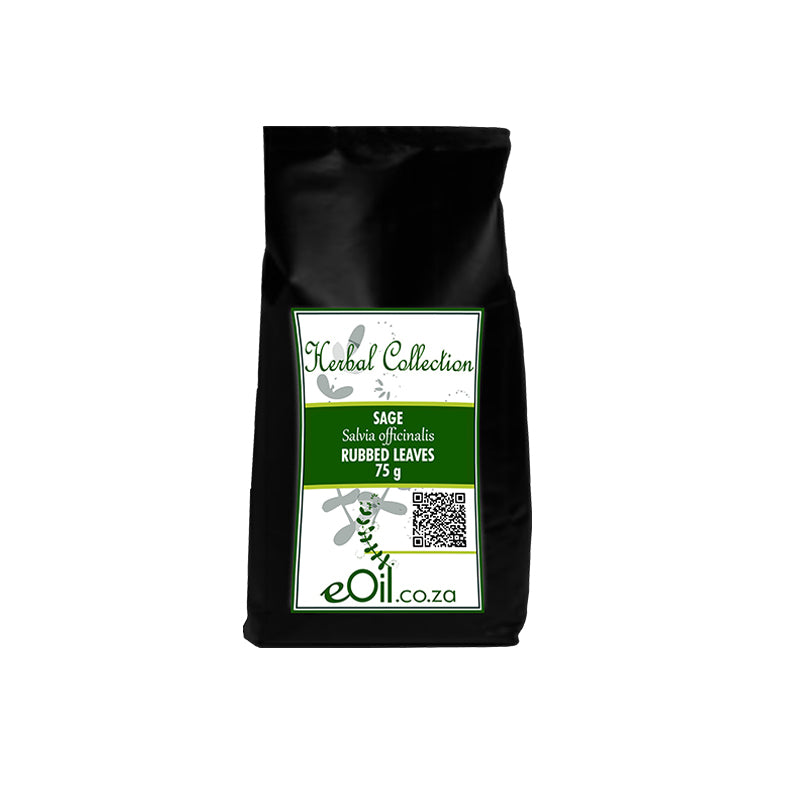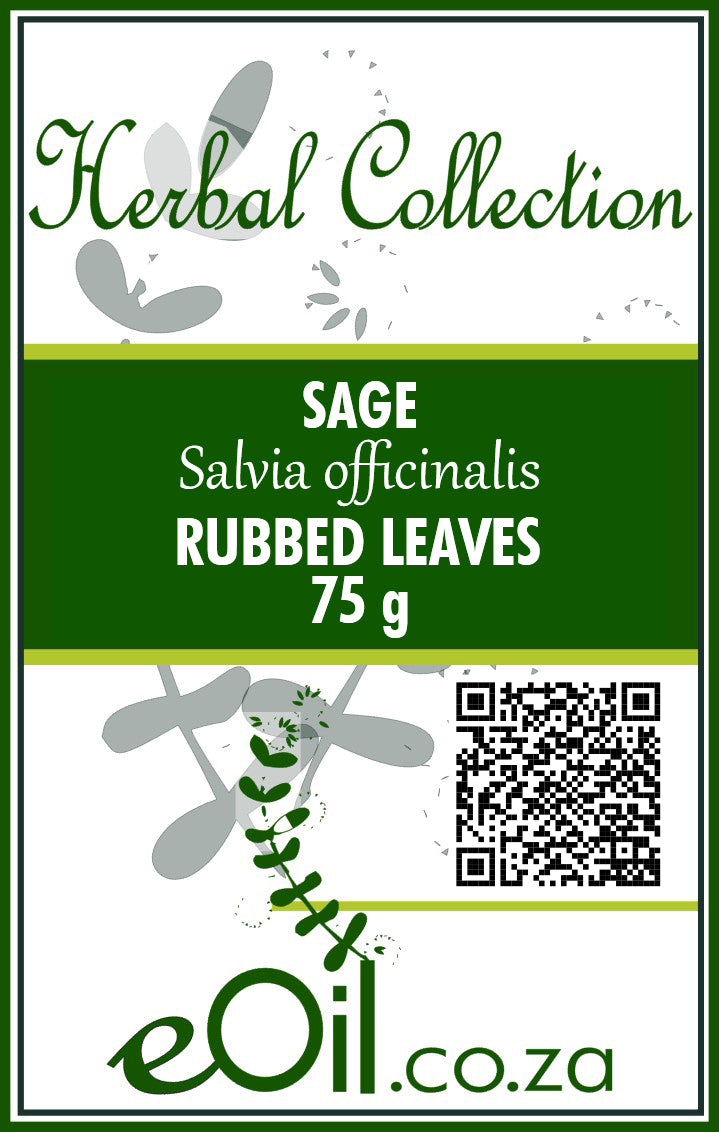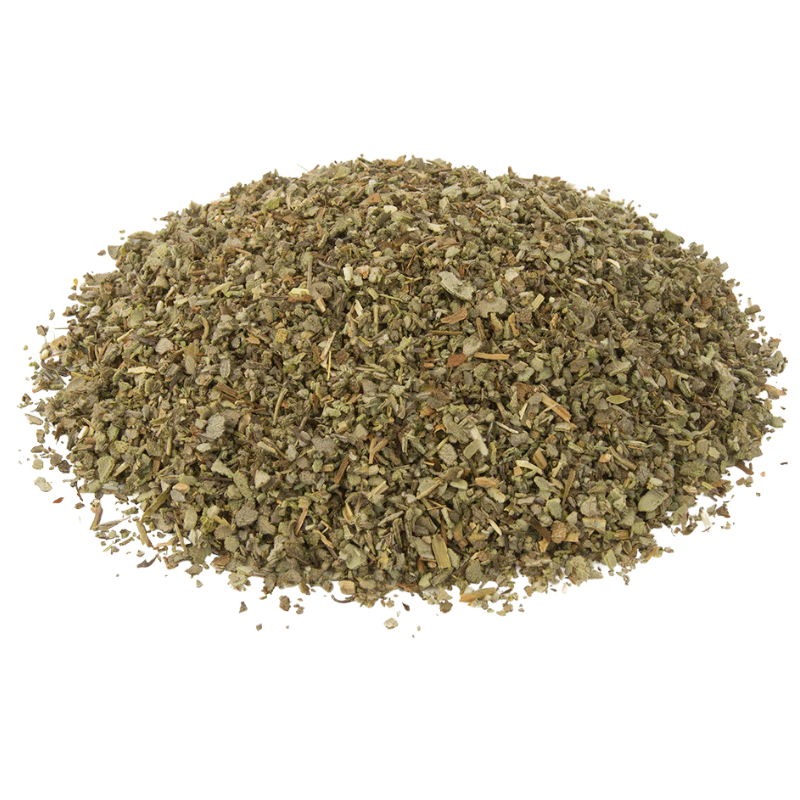Sage Rubbed Leaves Dried - Herbal Collection
Sage Rubbed Leaves Dried - Herbal Collection - 75 GR is backordered and will ship as soon as it is back in stock.
Description
Description
Sage Rubbed Leaves Dried (Salvia officinalis) are premium, airy flakes created by gently rubbing dried sage leaves to preserve their aromatic, earthy flavor.
Perfect for seasoning poultry, meats, stuffing, and Mediterranean dishes, this natural herb is rich in antioxidants and nutrients, supporting flavor and wellness in everyday cooking
TRADITIONALLY USED FOR
May help with
- estrogenic
- hot flashes
- Menopause
- Reduce loss bones
- antioxidant
- anti-inflammatory
- anti diabetic
- improves memory
- anti arrhythmic
- antiphlogistic
Here are some additional recipes for tisanes that can help with menopause symptoms, excessive sweating, and overall well-being:
Sage and Lemon Balm Tisane
Ingredients:
- 1 teaspoon dried sage leaves
- 1 teaspoon dried lemon balm leaves
- 1 cup boiling water
Instructions:
- Combine the sage and lemon balm in a tea infuser or teapot.
- Pour boiling water over the herbs.
- Steep for 5-10 minutes.
- Strain and enjoy.
This blend may help reduce hot flashes and night sweats associated with menopause
Black Cohosh and Red Clover Tea
Ingredients:
- 1 teaspoon dried black cohosh root
- 1 teaspoon dried red clover blossoms
- 1 cup boiling water
Instructions:
- Mix the black cohosh and red clover in a tea infuser.
- Add boiling water and steep for 10-15 minutes.
- Strain and drink.
Both black cohosh and red clover contain phytoestrogens that may help alleviate menopausal symptoms
Cooling Mint and Hibiscus Blend
Ingredients:
- 1 teaspoon dried peppermint leaves
- 1 teaspoon dried hibiscus flowers
- 1 cup boiling water
Instructions:
- Combine peppermint and hibiscus in a tea infuser.
- Pour boiling water over the herbs.
- Steep for 5-7 minutes.
- Strain and serve hot or iced.
This refreshing blend may help cool the body and provide antioxidants
Calming Chamomile and Lavender Tea
Ingredients:
- 1 teaspoon dried chamomile flowers
- 1/2 teaspoon dried lavender buds
- 1 cup boiling water
Instructions:
- Mix chamomile and lavender in a tea infuser.
- Add boiling water and steep for 5-7 minutes.
- Strain and enjoy before bedtime.
This soothing blend may help improve sleep quality and reduce anxiety
Remember to consult with a healthcare professional before using herbal remedies, especially if you have any existing health conditions or are taking medications.
INFORMATION
Source : http://www.wikiphyto.org/wiki/Sage
Reference on http://www.wikiphyto.org
Translation in English by Google Translate (go to the page of the source linked | on Chrome cellphones go on the 3 dots on the top right and select translate in your preferred language | on laptop right click your mouse and select option translate when hoovering on the page
plant name
Sage officinalis, Sacred herb , European tea
International Latin denomination
botanical family
Lamiaceae
Description and habitat
- Calcareous soils of the Mediterranean region
- Subshrub 70 cm high, perennial, branched, woody at its base, very aromatic
History and tradition
- Sacred herb of the Latins, praised by Dioscorides and Galen for its emmenagogue and tonic properties
- The genus name Salvia comes from the Latin “salvare”
- Vulnerable species or Swiss tea from the 1949 Codex:
- Leaves and tops of wormwood , betony , calamentum , germander , hyssop , ground ivy , oregano , periwinkle , rosemary , sage , scolopendra , scordium , thyme , veronica ; arnica flowers , cat's foot , coltsfoot ; in equal parts
- Salvia miltiorrhiza , used in Chinese medicine, exhibits anti-osteoporotic properties [1]
Parts used
- Leaves or flowering tops
Dosage forms available
- Leaf tea
- Mother tincture of aerial parts
- Dry extracts
- Fluid extract
- Flowering plant essential oil (to be avoided due to the presence of thujone )
Usual dosages
- 1.5 grams of finely cut drug, as an infusion, repeated 3 to 4 times a day
- TM Salvia officinalis 50 drops morning and evening
Composition
Main components of the plant
- Essential oil (1 - 2.5%) containing 35 - 60% thujone
- Tannins (3 - 7%) and phenolic compounds including rosmarinic acid (called " tannin of the labiatae " or Lamiaceae )
- Diterpenes : carnosic acid and carnosol (= picrosalvin), rosmanol , safficinolide
- Flavonoids (1 - 3%): luteolin , 5-methoxysalvigenin
- Triterpenes : very rich in oleanolic acid (400 ppm) and derivatives, ursolic acid
Main components of buds or young shoots
Main components of essential oil
- Ketones : thujone 35-70 % (mixture of alpha-thujone and beta-thujone ), camphor 8-37%
- Monoterpenes : limonene
- Sesquiterpènes 8 - 15 %
- 1,8-cineole 8-24%, borneol
- Salviol ( diterpenol )
Properties
Plant properties
- Antiperspirant (sweats of tuberculosis, chronic diseases)
- Estrogenic, anti-galactogenic activity
- Salvia officinalis tincture reduces the frequency and intensity of hot flashes and associated menopausal signs [2] , the putative estrogenic principle has been identified as luteolin-7-O-glucoside [3]
- Sage increases the number of lobules (milk producing units) in the mammary gland [4] and thereby prepares the breast for lactation
- Consumption of sage tea could improve female fertility via the hypothalamic-pituitary-ovarian axis, by increasing serum levels of FSH, LH, estrogen and progesterone hormones [5] , improves fertility in mice [6]
- Sage reduces bone loss by inhibiting resorption in rats [7]
- Powerful antioxidant activity ( flavonoids , rosmarinic acid ) [8] , [9] (use in charcuterie)
- Antibacterial [10] and antifungal
- Antiviral [11] , [12]
- Analgesic and anti-inflammatory [13]
- Antidiabetic [14]
- Diterpenes ( carnosic acid and carnosol ) induce inhibition of pancreatic lipase enzyme activity and decreased postprandial elevation of triglycerides, leading to reduced weight gain [15] , neuroprotective [16] , anti-cancer [17]
- Anti-mutagenic [18]
- Improves memory in the elderly [19] , and cognitive functions in patients with Alzheimer's disease [20] , [21] , cholinesterase inhibition [22] , memory enhancement [23]
- Strongly anti-asthenic due to essential oil and rosmarinic acid
- Cardiac tonic and antiarrhythmic ( oleanolic acid , ursolic acid )
- Topical anti-inflammatory ( ursolic acid ) [24]
- Antiphlogistic in oral and pharyngeal affections, gingivitis, stomatitis
- The aqueous extract inhibits the enzyme responsible for the collagenolytic activity of Porphyromonas gingivalis (responsible for canker sores)
Bud properties
Properties of essential oil
- Attention, the HE is toxic (twice as much as that of absinthe ): 0.3 grams are enough to kill a dog
- Convulsant: causes violent epileptiform seizures
- Thujone may be antagonized by trans-anethole
- Anticatarrhale, mucolytique, expectorante
- Antibacterial [25] , against Gram-positive ( Staphylococcus aureus ) and Gram-negative ( Pseudomonas aeruginosa ) bacteria often responsible for nosocomial illnesses [26] , [27]
- Antifungal [28]
- estrogen-like ( salviol )
- Healing
- Lipolytique
- Tonic and stimulating
- Low dose hepatoprotective [29]
Indications
Indications of the whole plant (phytotherapy)
- Amenorrhea, oligomenorrhea, menopause
- Ovarian stimulation (it will not be effective in case of oophorectomy)
- Female infertility, ovulation stimulation
- Male infertility in obese rats [30]
- Autonomic dystonias
- Minor heart failure and arrhythmias
- Oral and pharyngeal disorders, gingivitis, stomatitis
- Digestive disorders, bloating, colitis, diarrhea
- Slow digestion, belching, flatulence
- Asthenia, anemia
- Potentialities in Alzheimer's disease [31] , [32]
Indications of the bud (gemmotherapy)
Specific indications of essential oil (aromatherapy)
- Internal use strongly discouraged
- Amenorrhea, oligomenorrhea, premenopause
- Aphtoses
- Neuritis
- Flu, bronchitis, sinusitis
Known or suspected mode of action
- Rosmarinic acid is anti-asthenic
- Carnosol and carnosic acid are powerful anti-oxidants
- Thujone may be antagonized by trans-anethole
- According to AFSSAPS and AFSSA, “although officinalis sage ( Salvia officinalis L.), although found in all directories of phytoestrogen plants, has not demonstrated its activity” (estrogenic) [33]
- Nevertheless, luteolin-7-O-glucoside has been identified to have estrogenic properties [3].
Usual formulations
- an infusion morning and evening (one teaspoon per cup)
- 50 drops of mother tincture morning and evening
Regulations
- French Pharmacopoeia list A (sheet)
- Activity recognized by the German Commission E
Possible side effects and precautions for use
- Plant:
- Estrogenic effects by overdose or prolonged use (more than 15 grams of leaves per dose)
- More than 15 g of sage leaves are likely to cause heat sensation, tachycardia, dizziness and epileptiform seizures [34]
- Contraindication in case of hormone-dependent cancer (breast, ovary)
- Toxicity described at high dose (0.5 g/ml) for oocytes [35]
- Sage would prevent the biotransformation of tamoxifen into active product (inhibition of cytochrome CYP2D6?)
- Essential oil :
Bibliographic references
- Go↑ Cui Y, Bhandary B, Marahatta A, Lee G, Li B, Kim D, Chae S, Kim H, Chae H. Characterization of Salvia Miltiorrhiza ethanol extract as an anti-osteoporotic agent. BMC Complementary and Alternative Medicine 2011, 11:120 (28 November 2011), texte intégral en PDF [1]
- Go↑ Bommer S, Klein P, Suter A. First time proof of sage's tolerability and efficacy in menopausal women with hot flushes. Adv Ther. 2011 Jun;28(6):490-500. doi: 10.1007/s12325-011-0027-z. PMID 21630133
- ↑Go to :3,0 et 3,1 Rahte S, Evans R, Eugster PJ, Marcourt L, Wolfender JL, Kortenkamp A, Tasdemir D. Salvia officinalis for hot flushes: towards determination of mechanism of activity and active principles. Planta Med. 2013 Jun;79(9):753-60. doi: 10.1055/s-0032-1328552. PMID 23670626
- Go↑ Monsefi M, Abedian M, Azarbahram Z, Ashraf MJ. Salvia officinalis L. induces alveolar bud growing in adult female rat mammary glands. Avicenna J Phytomed. 2015 Nov-Dec;5(6):560-7. PMID 26693413
- Go↑ Huda Kareem Sarbiot Al- bediry & Jafar Abbas Issa Al- Maamori. Physiological Efficiency of Sage Tea (salvia officinalis L.) Administration on Fertility in Adult Female Rats. Journal Of Wassit For Science & Medicine, 2013, Volume 6, Issue 1, Pages 93-104 texte intégral en pdf
- Go↑ Al-Ani, B. T., Al Saadi, R. R., & Reshan, R. G. (2020). Investigating Effects of Salvia Officinalis (Sage) on Development of Mice Embryos Kidney and Some Hormonal Effect of Treated Mothers. Indian Journal of Forensic Medicine & Toxicology, 14(1), 649-654.
- Go↑ Abdallah, Inas & Khattav, Hala & Sawiress, Francois & A. S. El-Banna, Rokia. (2010). Effect of Salvia Officinalis L. (Sage) Herbs on Osteoporotic Changes in Aged Non-Cycling Female Rats. Med. J. Cairo Univ., Vol. 78, No. 1, March: 1-9, 2010
- Go↑ Schwarz K, Ternes W. Antioxidative constituents of Rosmarinus officinalis and Salvia officinalis. II. Isolation of carnosic acid and formation of other phenolic diterpenes. Z Lebensm Unters Forsch. 1992 Aug;195(2):99-103. PMID 1529648
- Go↑ Yinrong Lu, L Yeap Foo. Antioxidant activities of polyphenols from sage (Salvia officinalis). Food Chemistry, Volume 75, Issue 2, November 2001, Pages 197-202
- Go↑ Bachir, Raho & Zouaoui, Benattouche & Bevilacqua, Antonio & Corbo, Maria & Sinigaglia, Milena & S, Pignatiello. (2016). Antimicrobial Activity of Extracts from Salvia officinalis L on some Bacteria and Yeast. Journal of Biotechnology Research. 2. 31-35. texte intégral
- Go↑ Nolkemper S, Reichling J, Stintzing FC, Carle R, Schnitzler P. Antiviral effect of aqueous extracts from species of the Lamiaceae family against Herpes simplex virus type 1 and type 2 in vitro. Planta Med. 2006 Dec;72(15):1378-82. PMID 17091431
- Go↑ Masahiro Tada, Kenji Okuno, Kazuhiro Chiba, Eiko Ohnishi, Takao Yoshii. Antiviral diterpenes from Salvia officinalis. Phytochemistry, Volume 35, Issue 2, January 1994, Pages 539-541
- Go↑ Qnais EY, Abu-Dieyeh M, Abdulla FA, Abdalla SS. The antinociceptive and anti-inflammatory effects of Salvia officinalis leaf aqueous and butanol extracts. Pharm Biol. 2010 Oct;48(10):1149-56. doi: 10.3109/13880200903530763. PMID 20860437
- Go↑ Alarcon-Aguilar FJ, Roman-Ramos R, Flores-Saenz JL, Aguirre-Garcia F. Investigation on the hypoglycaemic effects of extracts of four Mexican medicinal plants in normal and alloxan-diabetic mice. Phytother Res. 2002 Jun;16(4):383-6. PMID 12112298
- Go↑ Ninomiya K, Matsuda H, Shimoda H, Nishida N, Kasajima N, Yoshino T, Morikawa T, Yoshikawa M. Carnosic acid, a new class of lipid absorption inhibitor from sage. Bioorg Med Chem Lett. 2004 Apr 19;14(8):1943-6. PMID 15050633
- Go↑ de Oliveira MR. The Dietary Components Carnosic Acid and Carnosol as Neuroprotective Agents: a Mechanistic View. Mol Neurobiol. 2016 Nov;53(9):6155-6168. doi: 10.1007/s12035-015-9519-1. PMID 26553346
- Go↑ Petiwala SM, Johnson JJ. Diterpenes from rosemary (Rosmarinus officinalis): Defining their potential for anti-cancer activity. Cancer Lett. 2015 Oct 28;367(2):93-102. doi: 10.1016/j.canlet.2015.07.005. PMID 26170168
- Go↑ Simic D, Vukovic-Gacic B, Knezevic-Vukcevic J, Trninic S, Jankov R. M. Antimutagenic effect of terpenoids from sage (Salvia officinalis L.). Journal of environmental pathology, toxicology and oncology, 1997, vol. 16, no 4, pp. 293-301 [2]
- Go↑ Scholey AB, Tildesley NT, Ballard CG, Wesnes KA, Tasker A, Perry EK, Kennedy DO. An extract of Salvia (sage) with anticholinesterase properties improves memory and attention in healthy older volunteers. Psychopharmacology (Berl). 2008 May;198(1):127-39. doi: 10.1007/s00213-008-1101-3. PMID 18350281.
- Go↑ S. Akhondzadeh, M. Noroozian, M. Mohammadi, S. Ohadinia, A. H. Jamshidi, M. Khani. Salvia officinalis extract in the treatment of patients with mild to moderate Alzheimer's disease: a double blind, randomized and placebo-controlled trial. Journal of Clinical Pharmacy and Therapeutics, Volume 28, Issue 1, pages 53–59, February 2003 [3]
- Go^ Leopoldo Luiz dos Santos-Neto, Maria Alice de Vilhena Toledo, Patrícia Medeiros-Souza, and Gustavo Almeida de Souza. The Use of Herbal Medicine in Alzheimer's Disease—A Systematic Review. Evid Based Complement Alternat Med. 2006 December; 3(4): 441–445. [4]
- Go↑ Kennedy DO, Pace S, Haskell C, Okello EJ, Milne A, Scholey AB. Effects of cholinesterase inhibiting sage (Salvia officinalis) on mood, anxiety and performance on a psychological stressor battery. Neuropsychopharmacology. 2006 Apr;31(4):845-52. PMID 16205785
- Go↑ Miroddi M, Navarra M, Quattropani MC, Calapai F, Gangemi S, Calapai G. Systematic review of clinical trials assessing pharmacological properties of Salvia species on memory, cognitive impairment and Alzheimer's disease. CNS Neurosci Ther. 2014 Jun;20(6):485-95. doi: 10.1111/cns.12270. PMID 24836739
- Go↑ Baricevic D, Sosa S, Della Loggia R, Tubaro A, Simonovska B, Krasna A, Zupancic A. Topical anti-inflammatory activity of Salvia officinalis L. leaves: the relevance of ursolic acid. J Ethnopharmacol. 2001 May;75(2-3):125-32. PMID 11297842
- Go↑ Ana Paula Longaray Delamare, Ivete T. Moschen-Pistorello, Liane Artico, Luciana Atti-Serafini, Sergio Echeverrigaray. Antibacterial activity of the essential oils of Salvia officinalis L. and Salvia triloba L. cultivated in South Brazil. Food Chemistry, Volume 100, Issue 2, 2007, Pages 603-608
- Go↑ V.-G. from Billerbeck. Essential oils and antibiotic resistant bacteria. Essential oils and antibiotic-resistant bacteria. Phytotherapy, Volume 5, Number 5, 249-253
- Go↑ Sonboli A, Babakhani B, Mehrabian AR. Antimicrobial activity of six constituents of essential oil from Salvia. Z Naturforsch C. 2006 Mar-Apr;61(3-4):160-4. PMID 16729570
- Go↑ Parisa Badiee, Abdol Reza Nasirzadeh, Mahshid Motaffaf. Comparison of Salvia officinalis essential oil and antifungal agents against Candida species. Journal of Pharmaceutical Technology & Drug Research, Open access texte intégral
- ↑Go to :29,0 et 29,1 Lima CF, Carvalho F, Fernandes E, Bastos ML, Santos-Gomes PC, Fernandes-Ferreira M, Pereira-Wilson C. Evaluation of toxic/protective effects of the essential oil of Salvia officinalis on freshly isolated rat hepatocytes. Toxicol In Vitro. 2004 Aug;18(4):457-65. PMID 15130603
- Go↑ Elwakf, Azza & El-Habibi, Elsayed & Abd El-Ghany, Eman. (2015). Preventing male infertility by marjoram and sage essential oils through modulating testicular lipid accumulation and androgens biosynthesis disruption in a rat model of dietary obesity. Egyptian Journal of Basic and Applied Sciences. 5. 10.1016/j.ejbas.2015.05.005.
- Go↑ Lopresti AL. Salvia (Sage): A Review of its Potential Cognitive-Enhancing and Protective Effects. Drugs R D. 2017 Mar;17(1):53-64. doi: 10.1007/s40268-016-0157-5. PMID 27888449
- Go↑ Ameen, Nazima, and Sabeeha Shafi. Herbal treatment for Alzheimers disease. International Journal of Pharmacy & Technology| June-2017| Vol. 9 | Issue No.2 | 5959-5968
- Go↑ Safety and benefits of phytoestrogens provided by food – AFSSAPS and AFSSA recommendations full text
- Go↑ Final European Union herbal monograph on Salvia officinalis L., folium - Revision 1 - 13/07/2017 EMA/HMPC/277152/2015 EMA
- Go↑ Monsefi M, Nadi A, Alinejad Z. The effects of Salvia officinalis L. on granulosa cells and in vitro maturation of oocytes in mice. Int J Reprod Biomed (Yazd). 2017 Oct;15(10):649-660. PMID 29387831
- Go↑ Halicioglu O, Astarcioglu G, Yaprak I, Aydinlioglu H. Toxicity of Salvia officinalis in a newborn and a child: an alarming report. Pediatr Neurol. 2011 Oct;45(4):259-60. doi: 10.1016/j.pediatrneurol.2011.05.012. PMID 21907890 Comment in : Lachenmeier DW, Walch SG. Epileptic seizures caused by accidental ingestion of sage (Salvia officinalis L.) oil in children: a rare, exceptional case or a threat to public health? Pediatr Neurol. 2012 Mar;46(3):201; author reply 201. doi: 10.1016/j.pediatrneurol.2012.01.009. PMID 22353306
- Zihlif M, Afifi F, Abu-Dahab R, Abdul Majid Am, Somrain H, Saleh MM, Nassar ZD, Naffa R. The antiangiogenic activities of ethanolic crude extracts of four salvia species. BMC Complementary and Alternative Medicine 2013, 13:358 (13 December 2013) Abstract texte intégral
CAUTION
Store in a cool, dry place, away from light. Keep tightly closed, away from the reach of Children and pets.
Do not exceed the daily dose.
This product is not intended to prevent or cure any form of illness or disease.
If you are pregnant or nursing ; If you have a medical condition or are in the course of medical treatment ; If you are programmed for theater/operation in the near future, please consult your healthcare practitioner before using this product.
This product cannot replace a varied and balanced diet and a healthy lifestyle.
This product has not been evaluated by the SAHPRA for its quality, safety or intended use.
For More Information please check our General Safety Herbal products Page






